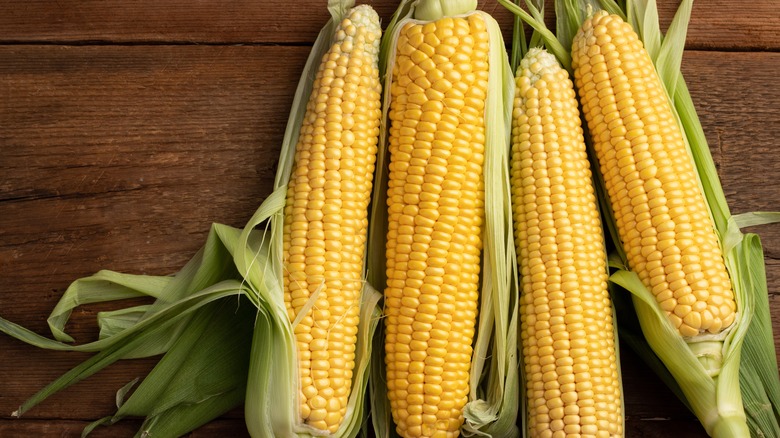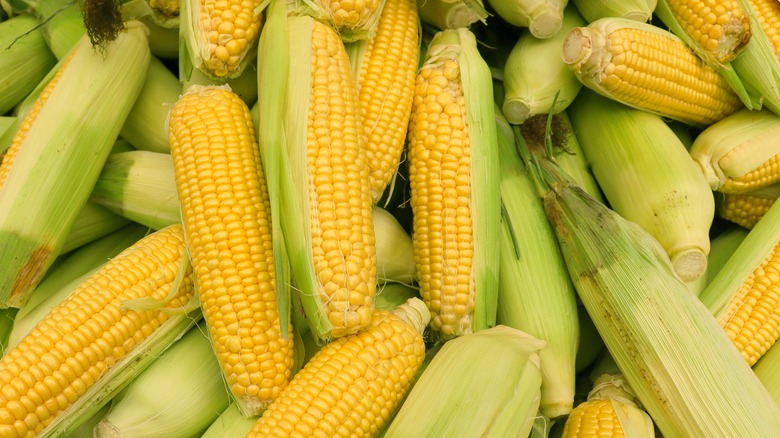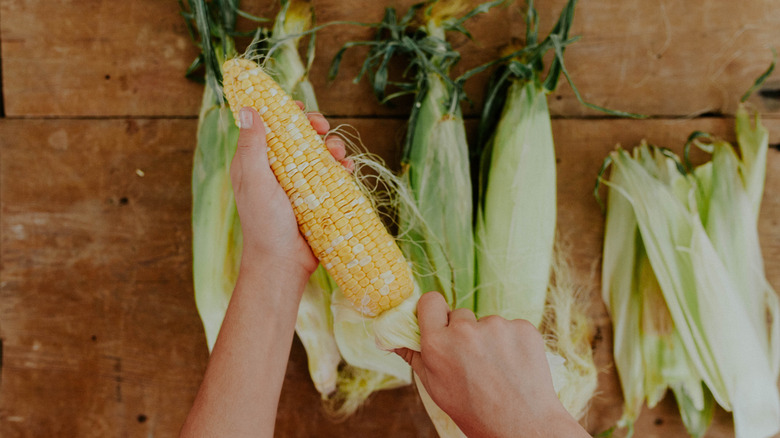Store Your Fresh Corn With The Husk On For Juicier Kernels
If there's one thing to know about corn, it's that it's best enjoyed as soon as you bring it home. Cook the cobs a day or two later and you'll notice that the kernels no longer look as plump and juicy as they once did. This is because two things happen when corn is harvested: The cobs no longer have any source of water to keep those kernels succulent, and the natural sugars present inside break down into starch. As a result, corn becomes drier, starchier, and less sweet the longer it sits out after harvest.
There is a way to slow down this process though, and keep the kernels super juicy — the trick is to keep the husk intact. This outer covering will seal the moisture inside the corn cob and prevent it from drying out. While you could get away with plucking out a few leaves to make the husk neater to store, don't shuck it entirely until you're ready to cook it.
You should also consider storing corn in the refrigerator. The cold temperature will slow down the starch conversion and help those kernels preserve their sweetness for longer. To do so, pop the corn in a plastic bag for a second barrier to prevent moisture loss in the refrigerator. Make sure to wrap the bag loosely so that there's enough air passing through — you don't want an excess of moisture making your corn moldy.
Look for these signs of freshness when buying corn
While leaving the husks on corn can help the kernels preserve their sweet juice, it won't do much good if you've bought ears from the store that are already past their prime. Corn's flavor and succulence depends on its freshness, so it's important to pick the ripest one from the get-go if you'd rather not hunt for ways to bring out the sweetness in mediocre corn cobs later.
It goes without saying that you should look for corn that still has its husk on and is kept refrigerated. Next, inspect the husk closely without pulling it apart: The leaves should have a striking green hue and be wrapped tightly around the cob inside. Stay away from corn with dull, withered, and brown husks, or from anything that has holes, cavities, or any signs of spoilage.
You can also tell a lot about corn's freshness by those dainty thread-like silk fibers: They should be moist and pale golden in color rather than limp, slimy, or dark. Don't hesitate to pick the ears up either. Fresh corn will feel weighty from the juice inside, and anything that seems lighter than it looks is the sign of a corn that has more starch than sugar. It's also a good idea to feel the cob under your fingers through the husk: The kernels inside should feel nothing but full and firm.
How to shuck corn when you're ready to eat it
Admittedly, those protective husks can seem like pesky things to remove when it's time to take the corn out of the refrigerator and prep it for cooking. First there are those dry outer leaves to pull off, followed by the thin and tender inner leaves packed inside. Once they are off, there are also those stubborn threads of silk to wrestle with too! Now you could try using gripper pads, stiff toothbrushes, elastic bands, or rubber gloves to clean the corn cobs properly, but what if there was an easier way?
The trick for easily shucking corn is to use heat. You can either pop the entire ear in a pot of boiling water, or slice off the stem and place the corn in the microwave for a few seconds. Then, give the ear a good shake once it's nice and warm: The heat will loosen the husk and silk enough for the cob to slide right out of the chopped bottom. You can then slice the kernels off the cob with a knife. One thing to remember though is that microwaving the corn will only heat it enough to soften the kernels and make them easier to shuck — it won't cook them. You'll still need to prepare them as you usually would to make those Mexican street corn salads and cajun-style corn chowders.



